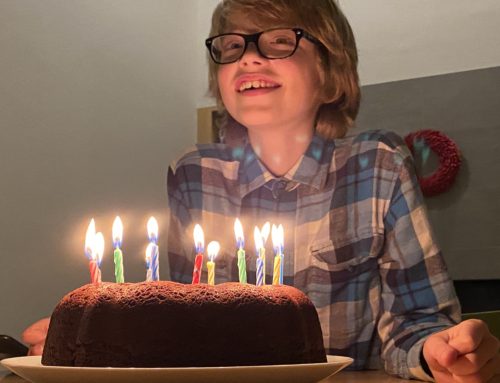For as long as I can remember, the last week in November was gingerbread week. My mom would be out of commission for four or five days—busy designing, baking, assembling, and decorating that year’s gingerbread house. Her houses are not your typical one-room cabins slathered in frosting and assorted candy—they are elaborate gingerbread mansions, decorated inside and out with painstaking precision.
The tradition started when my mom was a young mother, with one or two kids. (She now has seven children.) She remembered how when she was in elementary school the school secretary would make fantastic gingerbread houses and bring them to the school so the kids could look at them. My mom was just fascinated by them. That secretary was a family friend, so my mom and grandmother called her up those many years later and asked her to show them how to make them. That year she made a small one, only about three rooms and one floor.
The tradition and the houses themselves grew from there, until now she’s been making them for 45 years. When we were little, mom made them while we were sleeping or at school, since the houses are fairly fragile. But over time we would watch her make them and then contribute ideas and help with different parts of the construction—and of course with eating the candy. One of my brothers was the roof expert. He was the first one to use a saw to even out the baked pieces.
But most of all I loved looking at the finished product. I’d spend hours just examining all the details. My mom would hide little wood mice throughout the house, so we kids would always try to find them all. I remember breaking off the icicles and eating them with my brothers and sisters. Now that I know how hard those are to make, especially the long ones, that part makes me cringe.
My mom still makes her gingerbread houses almost every year, and has a huge collection of miniatures to decorate the inside, including several from Chile and Germany and other places she’s traveled. From time to time, she’d question whether it was worth the time and effort to keep making these houses, and whether her time would be better used in other ways, but a friend told her that the houses were her gift to her friends and family, and she liked that idea and continued making them.
Five years ago, I decided it was time to start making gingerbread houses of my own. I had a basic idea of how to do it, after watching my mom make them for all those years, and I called her often for advice. Now it has become one of my favorite weeks of the year. I enjoy designing the houses and filling my house with the smell of gingerbread on baking day, but my favorite part is decorating it and creating the scenes that I know my own children will spend hours examining like I once did. I let them help me here and there, but they lose interest and get bored pretty quickly, since they’re still little. Last year, my oldest daughter, Mary, made a little gingerbread shack which we put in the yard of the bigger house.
Day One: Designing
I always spend the first day creating a pattern for the house. I make a to-scale drawing and then cut patterns out of file folders, labeled carefully, so I know just where each piece will go.
Day Two: Baking
The next day, I make a huge batch (about 4-5 recipes) of gingerbread and fill about 15 baking sheets. My mom has been through several different recipes and has fine-tuned the one we now both use over the years. The one we use now is strong but it actually tastes good too. A word of caution: each recipe works differently depending on the humidity of where you live. My sister uses this recipe in Florida, but she can only make a one-story house because it can’t stand up to the humidity.
data-animation-override>
“Nanieve’s Gingerbread Recipe1 cup sugar
1 cup vegetable shortening
1 cup light corn syrup
1 tsp. baking soda
1 tsp. salt
1 Tbsp. ginger
1 Tbsp. cinnamon
1 tsp. cloves
5 Tbsp. water
5 cups flour
Mix all ingredients together in stand mixer. Roll out and cut as desired. No flour needed for rolling out. Cook at 350 until brown, about 20-25 minutes.”
Once I’ve mixed the dough, I roll it out and cut out the shapes based on my templates, using a cookie cutter and ruler. I bake them on the back side of cookie sheets so I can slide them right off when they’re baked. Then I trim down the sides to make sure they’re totally even, while the pieces are still hot. Then the pieces have to cool overnight to be strong enough to decorate. If I need to trim them again after they’ve cooled, I use a band saw.
Day Three: Decorating the Outside and Building the First Floor
The next day is more fun. I get to decorate the outside of the entire house. I use royal icing with a thick and gluey consistency for both decorating and to connect the pieces together. I decorate the outside walls when they’re laying flat, and then I assemble the first floor and position the figurines inside.
The base of my house is a hollow core door, cut down to 24-by-42 inches. I wait until the next day to assemble the second floor, because the icing has to get nice and hard before it’s strong enough to support the second story.
Day Four: Building the Second Floor and Putting on the Finishing Touches
On the last day, I get to finish off the top floor and do the outside. It’s so fun to see it all come together. First I cut a foam board to fit over the top of the first floor, and I tape Christmas lights onto the under side of it. Then I position it on top. I build the second floor on that foam board, position the next set of figurines, and then I build the roof.
I use seven-minute icing for the snow on the roof and in the yard, and for the icicles. It’s fluffy and glossy and is a nice finishing touch, but it’s harder to work with. It’s really fun to finish off the yard and put on all the final touches.
Once it’s finished, I display my house on the piano near my front entryway. My kids love looking at it and trying to find the miniature gingerbread men I hide throughout the house. Like my mother before me, these houses have become my gift to them and to my friends who look forward to seeing the finished product each year—the perfect way to kick off the Christmas season.













